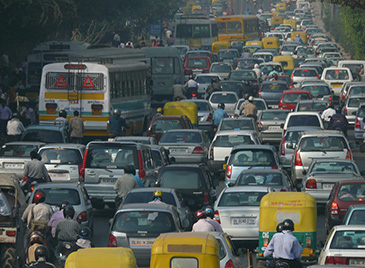Ground-level ozone's toll in India
Pollutant damages crops that could feed tens of millions
Sep 8, 2014 - by Staff
Sep 8, 2014 - by Staff
September 9, 2014 | Ozone pollution in India is damaging millions of tons of the country’s major crops, according to a new study by an international team of researchers. The pollution caused losses of more than $1 billion in a single year, destroying enough food to feed tens of millions of people living in poverty in the country.
The study used crop production data and a powerful, NCAR-based computer model to estimate the impacts of ozone. It was led by scientists at the Indian Institute of Tropical Meteorology (IITM) in Pune, India, with co-authors from the Scripps Institution of Oceanography and NCAR. The research was published last month in Geophysical Research Letters, a journal of the American Geophysical Union.
The researchers looked at the agricultural effects in 2005 of high levels of ground-level ozone, which damages plants and affects human health as well. They estimated that the pollutant ruined 6.7 million U.S. tons (6 million metric tons) of India’s wheat, rice, soybean, and cotton crops that year.
India could feed 94 million people with the lost wheat and rice crops, about one-third of the country’s population living in poverty, according to Sachin Ghude, an atmospheric scientist at the Indian Institute of Tropical Meteorology and lead author of the new study.

A traffic jam in Delhi, India. Automobile emissions in the presence of sunlight contribute to the formation of low-level ozone, a significant threat to human health and crop productivity. (Wikimedia Commons image courtesy NOMAD.)
Despite air quality standards passed in the 1980s that were designed to curb industrial and vehicle emissions, pollution remains a major challenge for India. Long-term measurements of surface ozone across India—measured on the ground or by aircraft—are not available, making it difficult to get a clear picture of how levels of the pollutant have changed. But satellite-based studies show ozone has increased in the last two decades, Ghude said.
To estimate ozone levels over specific regions of the country, the researchers turned to the chemistry version of the NCAR-based Weather Research and Forecasting (WRF) model. This powerful software tool enabled the researchers to simulate hourly ozone levels, based on six estimates of emissions. They then calculated the impact on yields of wheat, soybeans, cotton, and rice.
Although previous studies had looked at ozone damage at local levels, the study’s authors set out to conduct the first comprehensive look at how ozone pollution has affected agriculture in India on a national level.
Ghude said the new paper could help policymakers craft new ozone pollution standards and plan mitigation strategies to reduce damage to plants.
NCAR postdoctoral researcher Rajesh Kumar, a co-author of the study, said India's ozone problems will likely get worse with climate change. Research has shown that warmer temperatures tend to produce higher levels of ozone.
“This is a huge impact, but what we have now is not the worst-case scenario,” he said. “It will most likely get worse.”
Ghude, S. D., C. Jena, D. M. Chate, G. Beig, G. G. Pfister, R. Kumar, and V. Ramanathan (2014), Reductions in India's crop yield due to ozone, Geophysical Research Letters, 41, 5685–5691, doi:10.1002/2014GL060930.
Writer/Contact
David Hosansky, NCAR/UCAR Communications
Collaborating institutions
Indian Institute of Tropical Meteorology
National Center for Atmospheric Research
Scripps Institution of Oceanography
Funder
National Science Foundation